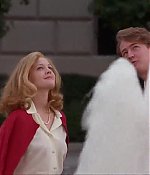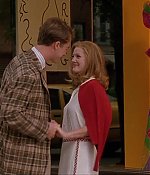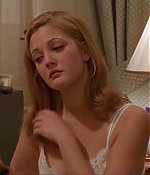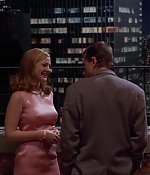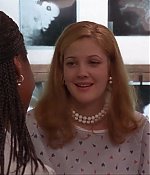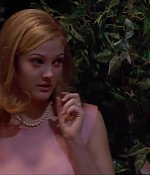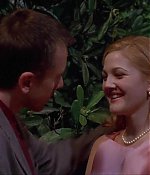Drew is currently filming The Stand-In in New York. I’ve added a bunch of photos from her on the set. I’m so excited to see this film! Enjoy.
It’s been 15 years since Adam Sandler tried to make an amnesia-stricken Drew Barrymore fall in love with him daily on an idyllic Hawaiian island in 50 First Dates. The film marked the second of the unofficial Barrymore-Sandler trilogy that began with 1998’s The Wedding Singer and concluded, at least for now, with 2014’s Blended. But it’s also an unexpected rom-com, given the very traumatic nature of the ailment suffered by Barrymore’s Lucy after a car crash leaves her waking up every morning with no memories of anything that happened to her after her accident. Sandler’s Henry, a notorious commitment-phobe, finds himself drawn to Lucy and making her fall in love with him from scratch every day.
In honor of the anniversary and as part of EW’s romantic-comedy-themed Untold Stories issue, director Peter Segal revealed some original script details that could have changed the story completely.
50 First Dates… in Seattle?
“Originally, the story was written to take place in Seattle, and when we decided to change it to Hawaii, it took on a whole new personality, and now I can’t imagine movie not having been filmed there because the island and the people became very unique characters and an innate part of the film that was never originally planned. [Seattle] would have completely changed the tone. One of the things I’ve been very proud of is that the soundtrack for the movie won a gold record, and it was very specifically ’80s covers that were done with an island vibe, and obviously we couldn’t have done that in Seattle.”50 First Dates… in a Cafe?
“The original script, most of it all took place in the cafe, and one of the first things I did when I came on board was, I said, ‘We really have to open up the movie because it feels very claustrophobic. We’ve got to get out of here, right now this is playing like My Dinner with Andre over and over again.’ Once I encouraged Adam to open up the movie and the script to write new scenes in the Kualoa Ranch, then came all the ideas of tying him up and using the penguin as a decoy, and Drew saving Adam with the baseball bat, kicking Rob Schneider’s ass. All those were a result of that, and they became some of the more memorable, hilarious scenes in the movie that were not there originally when it took place all in the cafe. It was fun to open that up.”50 First… Kisses?
“50 First Kisses was actually the original title of 50 First Dates, but marketing found that the term ‘kisses’ was turning off guys, so they changed it to 50 First Dates.”An Alternate Ending?
“This ending is very different from the original script version, which had Lucy waking up in bed and immediately looking at a mural on the ceiling that tells the story of her accident and life since. As her eyes pan from left to right, she turns to see Henry lying next to her in bed, and in this version, they didn’t have children. It was a mural that she painted that, unlike the mural in her father’s garage, which they painted over each day so she had a blank canvas to work on, this one Henry left up so that when she woke up in the morning she could see a pictorial timeline of her last day to reintroduce her. So by the time she finished panning with her eyes from left to right, she would come to rest on Henry, and unlike earlier in the movie when she woke up in bed with him and he was a stranger again and she screamed and had a reaction, it was a way of reintroducing her to her life again. And we thought that was fine, but it wasn’t until the idea came up of completing Henry’s journey and seeing him fulfill his dream of studying walruses in their natural habitat, the idea came up, well, what if Lucy, her father, and their child were all there with him, and that just seemed really exciting and very emotional to me. The hardest thing in movies is come up with a strong beginning and a strong end, and if you have that, you’ve got a shot, and I think to this day, it’s the best ending to any movie that I’ve done.”A Cure for Lucy?
“The studio debated, should Lucy be cured and it be a happy ending? And I’m so glad everyone supported this bittersweet ending because that’s what was so heartbreaking about it, that she has to re-experience this every day. And it’s so amazing what Henry does for her every day. It breaks your heart for both characters, what one has to go through and the other has to endure, and I think that’s part of the charm and heartbreak of it.”
– Source
I’ve added high quality screencaptures of Drew from Best Men to the gallery. Big thanks to my friend Marica for her help. More photos to come. Enjoy!
I’ve added screencaps to various Drew projects to the gallery: Waxwork II: Lost in Time, Motorama, and Wishful Thinking. I’m getting very close to having screencaps for over 80% of her filmography completed. Check back for more.
I’ve added blu-ray screencaptures of Drew from the 1996 film Everyone Says I Love You to the gallery. More photos to come. Enjoy!
The one and only Drew Barrymore is coming to the Bluegrass to film scenes for the movie “The Stand-In.”
The film is set to feature the commonwealth. Wrigley Media Group CEO Jayne Hancock says that the movie is “another fantastic Drew Barrymore romantic comedy.”
Around four to six scenes of the comedy will be filmed in the Bluegrass at the end of the month.
“It is quite an achievement and it’s all connections and that’s what we’ve been doing here,” said Wrigley Media Group President Misdee Wrigley Miller.
“The film is a romantic comedy in which Drew Barrymore plays an actress who is washed up and burnt out and she decides to swap with her stand-in to live a different life,” said Wrigley Media Group Executive Producer Ross Babbit. “My sister Jamie and I have been working in entertainment for a lot of years. I’ve done a lot work for HGTV, DIY Network and Travel Channel — numerous unscripted networks and she’s been on the scripted side all these years. So the idea of being able to work together on a project here in Lexington, has been awesome.”
Shooting locations are schedule to feature downtown Lexington, including the Courthouse, and downtown Versailles.
“I think people in Lexington will be excited to see the final movie, because they will recognize their town and everything that’s great about it,” said Babbit. “When you have the star power of a Drew Barrymore coming to town and validating that this is a place to shoot, encourages others to look at us and think of Lexington and greater commonwealth is attractive for filmmakers and TV-makers.”
Wrigley Media Group is asking for extras in Kentucky. You can apply here.
– Source
Kevin Williamson was a struggling actor in his 20s when he decided to try his hand writing the sort of slasher films he grew up loving. By then, he’d watched Halloween and Friday the 13th so many times that he knew every twist of the camera and jump scare by heart. “I wanted to write a horror movie that I’d want to watch,” he said. “But how do you scare an audience when all the magic tricks have been exposed?”
The answer, as it turned out, was Scream, the self-aware, meta horror ’90s hit about a group of teenagers who have watched all the horror movies, and then, one by one, are murdered. More than 20 years later, Scream is still scary. And everything that makes it great is on display in its electric opening scene: a twisted game of horror trivia, a beautiful girl, a pair of gruesome murders, a telephone ringing in an isolated house at night.
For Vulture’s package on the 100 Scares That Shaped Horror, Williamson shared the story behind how he conceived of the film’s iconic opening scene.
I knew all these horror movies inside and out, and I kept thinking: How do you scare an audience that grew up on VHS, that’s watched these movies over and over again? So I thought, we comment on the rules and then subvert them a bit — or, sometimes, we follow them exactly, and then you never know what you’re going to get. When you put your star actress in the opening scene and kill her, you’re putting everyone off their game.
I wanted the Janet Leigh moment. I always felt that once you killed the star of the movie, all bets are off. When we first did the movie, Drew was attached to play Sidney Prescott, and then we were trying to find a bigger actress to play the opening part. At the time, Alicia Silverstone was huge, coming off of Clueless, but then Drew told us, “I really just want to play the opening scene. That’s my favorite part of the movie.” And that was great by us.
I wanted her to be the classic, ingénue teenage girl, with that innocent face, in a white sweater and blond hair. At the time, Drew had jet black hair, and she’d just dyed it, so we couldn’t dye it back to blond. She had to wear a wig. I remember Wes saying, “let’s just think of her as a Catholic school girl. She does everything right, and she’s a perfect little girl, and she’s about to be eviscerated, and that’s it.” And I was like, “okay, works for me!” I just wanted the audience to relate to her on some emotional level, and that’s why casting was so important. You meet her and two minutes later she’s in danger. We need an instant connection.
That’s what Drew brought to it. You instantly related to her and the fear dancing in her eyes as she starts to get nervous and uncomfortable, and she starts to realize this is going south. It’s a great performance. Her body language in the beginning is very swirly and rhythmic. She pulls a knife out and slides it back in to the butcher block. She spins around. And then the minute she gets scared, her shoulders go inward and everything changes. If you watch it again, just watch her body language as it transforms.
Drew was very adamant that she didn’t want to see the man playing the voice. We had him in a separate tent, and we had to keep him away from Drew’s vision. She just wanted to hear the voice and be scared by the voice. She didn’t want to attach a face to it. She didn’t want to get one word wrong. And I’m talking even about her screams and her breaths and her “No! No! No!” She was on the mark. I was blown away by her rhythm. I’m always happy to have actors ad-lib, because that can be some of your best stuff and Matthew Lillard was a genius at it. But she was so careful.
A big inspiration for me was the opening scene of When a Stranger Calls with Carol Kane. It was one of those relentless scenes with mood and atmosphere and a slow build. In my first pass of the scene, Casey Becker was actually babysitting. Once I’d written it, I realized it wasn’t necessary. Really, the scene was about Casey’s boyfriend, who was outside strapped to a chair. And it was about the game, and the premise, and the setup, and the conceit of the world we’d created. I wanted it to be just long enough that the audience thinks she might survive it. And the only way to do that was to let it go on just a tad longer than it should. An opening scene shouldn’t go on longer than ten minutes, and this one went on much longer than that.
Once I latched onto the game, I do remember I had written way too many questions. Eventually I narrowed it down, and focused in on the trick question [“Name the killer in Friday the 13th.”] I had much harder questions in the beginning, and the scene really went on forever.
From the page to the screen, we changed some things based on the house and the location. Like, how she got out of the house, and when she looked up at the window and saw that he was staring down at her. All of those moments were created on the spot because of the house. We wanted a house with windows everywhere. Wes was always big on shooting on location. He always wanted to see out the windows, so that the audience could see the danger, or not see the danger that was lurking out there. Prior to the shooting, I went with him to the house and we walked it, and I went and rewrote the action scenes based on his blocking. It was my first experience of realizing that what I saw in my head was never what it actually is. That was a big learning experience, of learning how to let things go. But this is the process. It’s a group effort. It was mostly, “oh wow, this is not what I envisioned in my head — this is better.”
It took them five nights to shoot it. It was my first movie, and I had no idea what I was doing. I was just standing there, asking constant questions. Like, “what’s that? That’s a crane!” I remember the producer looking at me at one point and saying, “you might want to stop asking questions. He’s not here for you. This isn’t a study session.” And Wes was like, “no it’s cool, it’s cool.” I found Wes to be the most calming presence on the set. He saved all his dark impulses for the work. He was just this quiet captain. He always had a great connection with the actors because he was so quiet and intimate with them.
Watching the scene come to life was very emotional. I called my mom and dad on the phone and let them hear Wes screaming “cut!” It was a big deal. It was the beginning of my career. And you just never know how it’s going to play out — it was such a question mark. How lucky was I that my first movie would be something like that? Scream was just everything and more to me. And it still is.
– Source
I’ve added HD screencaps of Drew from her 2006 film Lucky You. Enjoy!
- « Previous Page
- 1
- 2
- 3
- 4
- …
- 9
- Next Page »

